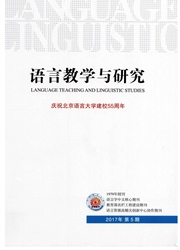

 中文摘要:
中文摘要:
本文对“来”的参照点问题进行了再考察,利用移动事件中移动主体、说话人、听话人和目标位置四个变量对“来”的各种使用情况进行了梳理,建立了“接收者”这一概念,从事件发生的可能性与必然性,及言语行为的角度对“来”“去”的使用与替换进行了论证,发现看似复杂的参照点变换问题实质上都围绕着说话人进行,体现了一种“近距离要求”,由此提出“自我关联”原则对“来”的各种用法进行系统解释。“来”的使用与选择,是客观要求与主观认识互动的结果。
 英文摘要:
英文摘要:
This paper reinvestigates the selection problem of the reference point ot motion verb lai (来). By a survey on the various uses of lai considering four variables in the motion events, i.e., the motion figure, the speaker, the listener and the destination, it finds that the seemingly complicated issue of reference point switching actually proceeds around the speakers, exhibiting a Proximity Requirement. Therefore, it puts forward a Self-relevance Principle to explain all the usage of lain the perspective of speakers. From the perspective of motion result, lai eventually manifests the unification of the four variables at the point of reference, which can simultaneously generalize the usage of lai syntactically and pragmatically.
 同期刊论文项目
同期刊论文项目
 同项目期刊论文
同项目期刊论文
 期刊信息
期刊信息
